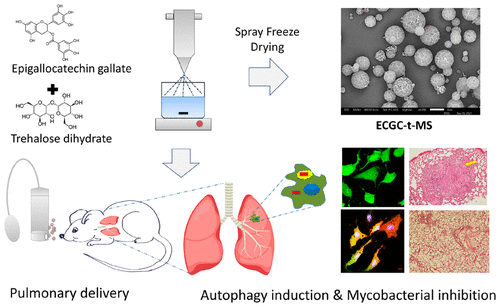当前位置:
X-MOL 学术
›
ACS Biomater. Sci. Eng.
›
论文详情
Our official English website, www.x-mol.net, welcomes your feedback! (Note: you will need to create a separate account there.)
Targeted Pulmonary Delivery of the Green Tea Polyphenol Epigallocatechin Gallate Controls the Growth of Mycobacterium tuberculosis by Enhancing the Autophagy and Suppressing Bacterial Burden
ACS Biomaterials Science & Engineering ( IF 5.8 ) Pub Date : 2020-06-11 , DOI: 10.1021/acsbiomaterials.0c00823 Ankur Sharma 1 , Kalpesh Vaghasiya 1 , Eupa Ray 1 , Pushpa Gupta 2 , Umesh Datta Gupta 2 , Amit Kumar Singh 2 , Rahul Kumar Verma 1
ACS Biomaterials Science & Engineering ( IF 5.8 ) Pub Date : 2020-06-11 , DOI: 10.1021/acsbiomaterials.0c00823 Ankur Sharma 1 , Kalpesh Vaghasiya 1 , Eupa Ray 1 , Pushpa Gupta 2 , Umesh Datta Gupta 2 , Amit Kumar Singh 2 , Rahul Kumar Verma 1
Affiliation

|
Growing rates of tuberculosis (TB) superbugs are alarming, which has hampered the progress made to-date to control this infectious disease, and new drug candidates are few. Epigallocatechin gallate (EGCG), a major polyphenolic compound from green tea extract, shows powerful efficacy against TB bacteria in in vitro studies. However, the therapeutic efficacy of the molecule is limited due to poor pharmacokinetics and low bioavailability following oral administration. Aiming to improve the treatment outcomes of EGCG therapy, we investigated whether encapsulation and pulmonary delivery of the molecule would allow the direct targeting of the site of infection without compromising the activity. Microencapsulation of EGCG was realized by scalable spray-freeze-drying (SFD) technology, forming free-flowing micrometer-sized microspheres (epigallocatechin-3-gallate-loaded trehalose microspheres, EGCG-t-MS) of trehalose sugar. These porous microspheres exhibited appropriate aerodynamic parameters and high encapsulation efficiencies. In vitro studies demonstrated that EGCG-t-MS exhibited dose- and time-dependent killing of TB bacteria inside mouse macrophages by cellular mechanisms of lysosome acidification and autophagy induction. In a preclinical study on TB-infected Balb/c mice model (4 weeks of infection), we demonstrate that the microencapsulated EGCG, administered 5 days/week for 6 weeks by pulmonary delivery, showed exceptional efficacy compared to oral treatment of free drug. This treatment approach exhibited therapeutic outcomes by resolution of inflammation in the infected lungs and significant reduction (P < 0.05) in bacterial burden (up to ∼2.54 Log10 CFU) compared to untreated control and orally treated mice groups. No pathological granulomas, lesions, and inflammation were observed in the histopathological investigation, compared to untreated controls. The encouraging results of the study may pave the avenues for future use of EGCG in TB therapeutics by targeted pulmonary delivery and lead to its translational success.
中文翻译:

绿茶多酚表没食子儿茶素没食子酸酯的靶向肺递送通过增强自噬和抑制细菌负担来控制结核分枝杆菌的生长。
结核病(TB)超级细菌的发病率令人担忧,这阻碍了迄今为止控制这种传染病的进展,而且新药候选者很少。表没食子儿茶素没食子酸酯(EGCG)是绿茶提取物中的主要多酚化合物,在体外显示出强大的抗结核细菌功效学习。然而,由于不良的药代动力学和口服给药后的低生物利用度,该分子的治疗功效受到限制。为了改善EGCG治疗的治疗结果,我们研究了分子的包封和肺部递送是否可以直接靶向感染部位而不损害活性。EGCG的微囊化是通过可扩展的喷雾冷冻干燥(SFD)技术实现的,形成了自由流动的微米大小的微球(海藻糖糖的微囊藻素-3-没食子酸酯的表面活性剂,EGCG-t-MS)。这些多孔微球表现出合适的空气动力学参数和高封装效率。体外研究表明,EGCG-t-MS通过溶酶体酸化和自噬诱导的细胞机制表现出了小鼠巨噬细胞内结核菌的剂量和时间依赖性杀灭。在一项针对TB感染的Balb / c小鼠模型(感染4周)的临床前研究中,我们证明了与口服游离药物口服治疗相比,微囊化EGCG(每周5天,每周6天通过肺部给药)显示出优异的疗效。这种治疗方法通过解决感染肺部的炎症和显着降低细菌负担(最高约2.54 Log 10),显示出治疗效果(P <0.05)与未处理的对照组和经口服处理的小鼠组进行比较。与未治疗的对照相比,在组织病理学研究中未观察到病理性肉芽肿,病变和炎症。该研究令人鼓舞的结果可能通过靶向肺部输送为将来在结核病治疗中使用EGCG铺平了道路,并使其转化成功。
更新日期:2020-07-13
中文翻译:

绿茶多酚表没食子儿茶素没食子酸酯的靶向肺递送通过增强自噬和抑制细菌负担来控制结核分枝杆菌的生长。
结核病(TB)超级细菌的发病率令人担忧,这阻碍了迄今为止控制这种传染病的进展,而且新药候选者很少。表没食子儿茶素没食子酸酯(EGCG)是绿茶提取物中的主要多酚化合物,在体外显示出强大的抗结核细菌功效学习。然而,由于不良的药代动力学和口服给药后的低生物利用度,该分子的治疗功效受到限制。为了改善EGCG治疗的治疗结果,我们研究了分子的包封和肺部递送是否可以直接靶向感染部位而不损害活性。EGCG的微囊化是通过可扩展的喷雾冷冻干燥(SFD)技术实现的,形成了自由流动的微米大小的微球(海藻糖糖的微囊藻素-3-没食子酸酯的表面活性剂,EGCG-t-MS)。这些多孔微球表现出合适的空气动力学参数和高封装效率。体外研究表明,EGCG-t-MS通过溶酶体酸化和自噬诱导的细胞机制表现出了小鼠巨噬细胞内结核菌的剂量和时间依赖性杀灭。在一项针对TB感染的Balb / c小鼠模型(感染4周)的临床前研究中,我们证明了与口服游离药物口服治疗相比,微囊化EGCG(每周5天,每周6天通过肺部给药)显示出优异的疗效。这种治疗方法通过解决感染肺部的炎症和显着降低细菌负担(最高约2.54 Log 10),显示出治疗效果(P <0.05)与未处理的对照组和经口服处理的小鼠组进行比较。与未治疗的对照相比,在组织病理学研究中未观察到病理性肉芽肿,病变和炎症。该研究令人鼓舞的结果可能通过靶向肺部输送为将来在结核病治疗中使用EGCG铺平了道路,并使其转化成功。



























 京公网安备 11010802027423号
京公网安备 11010802027423号